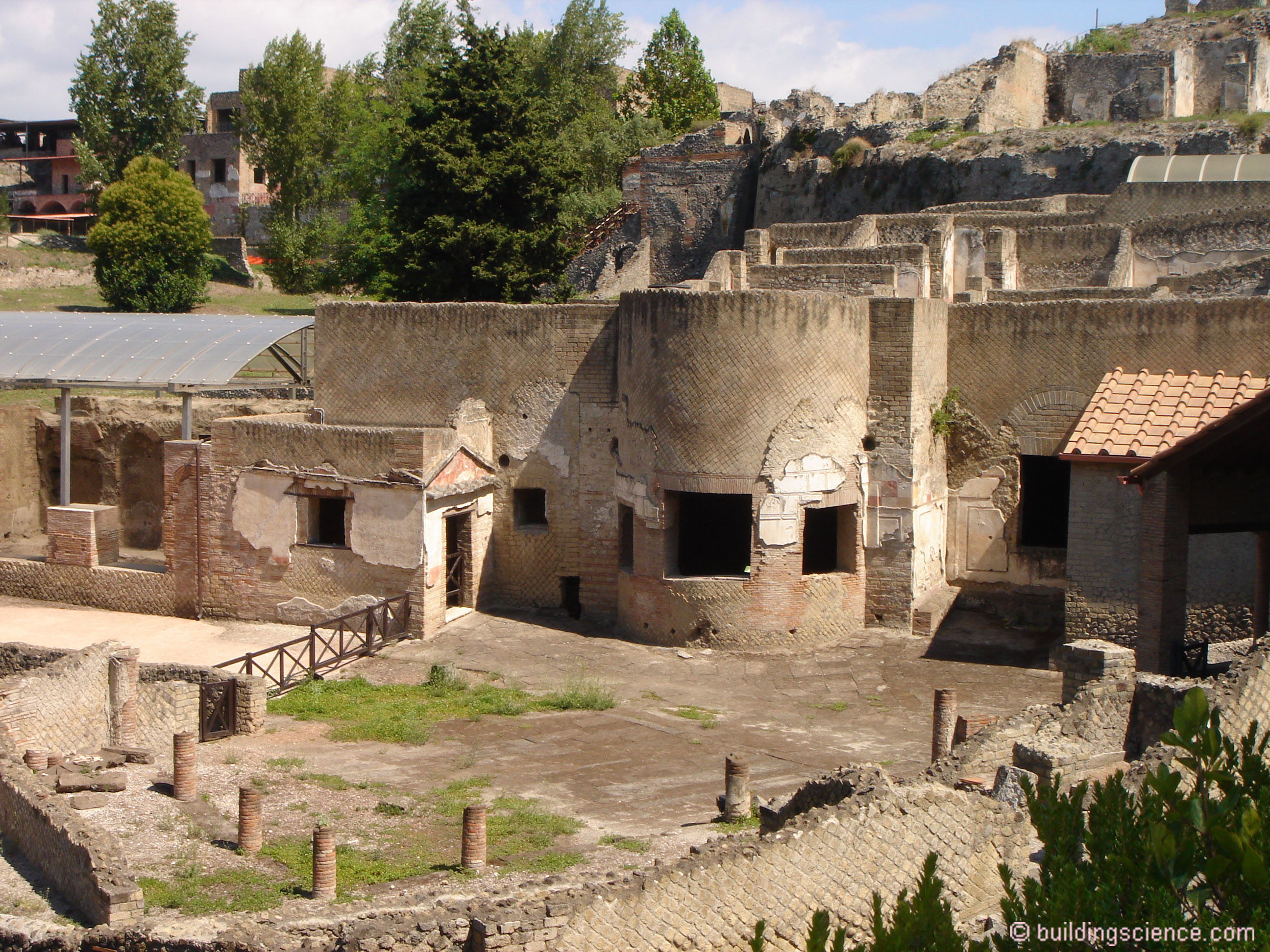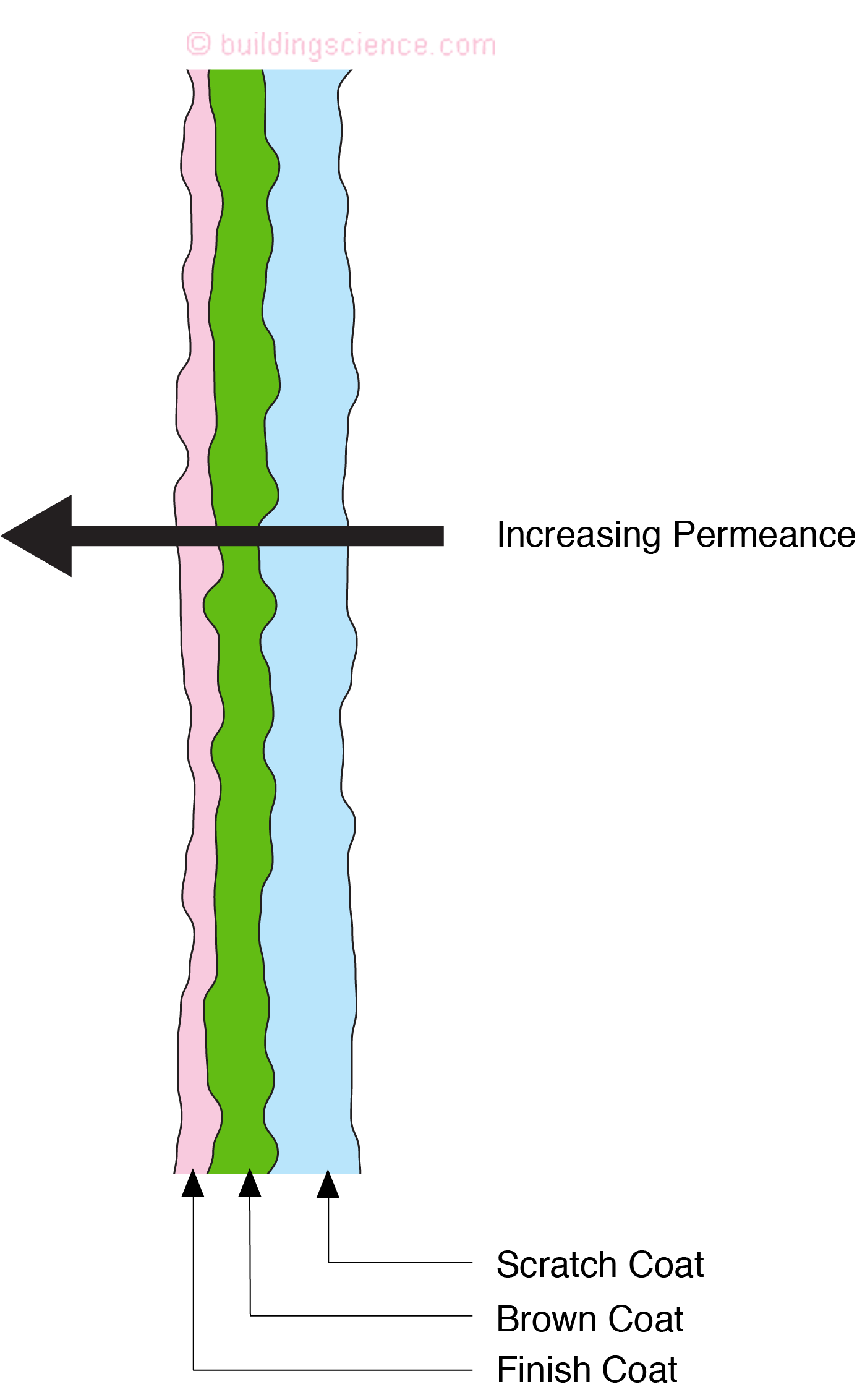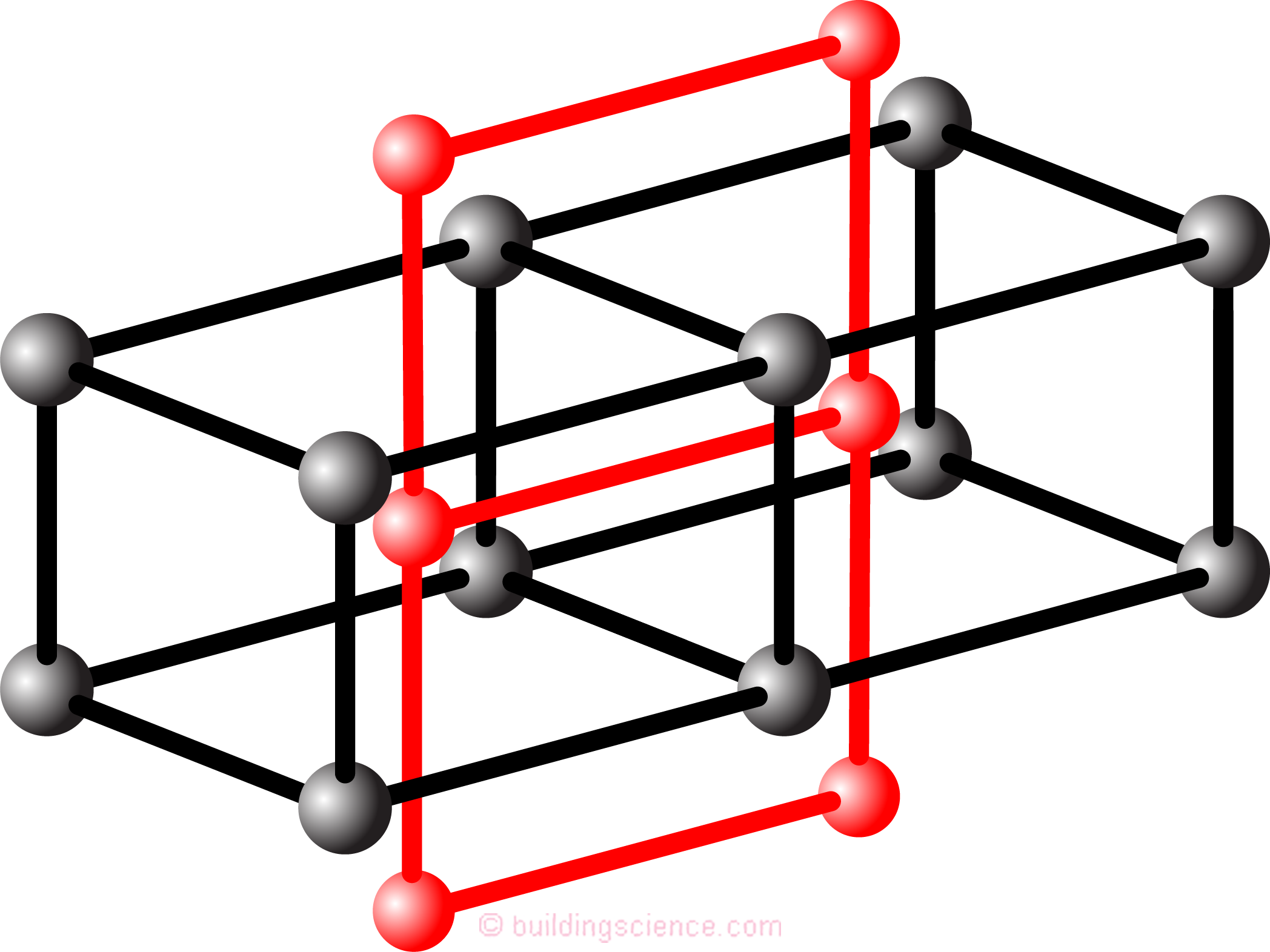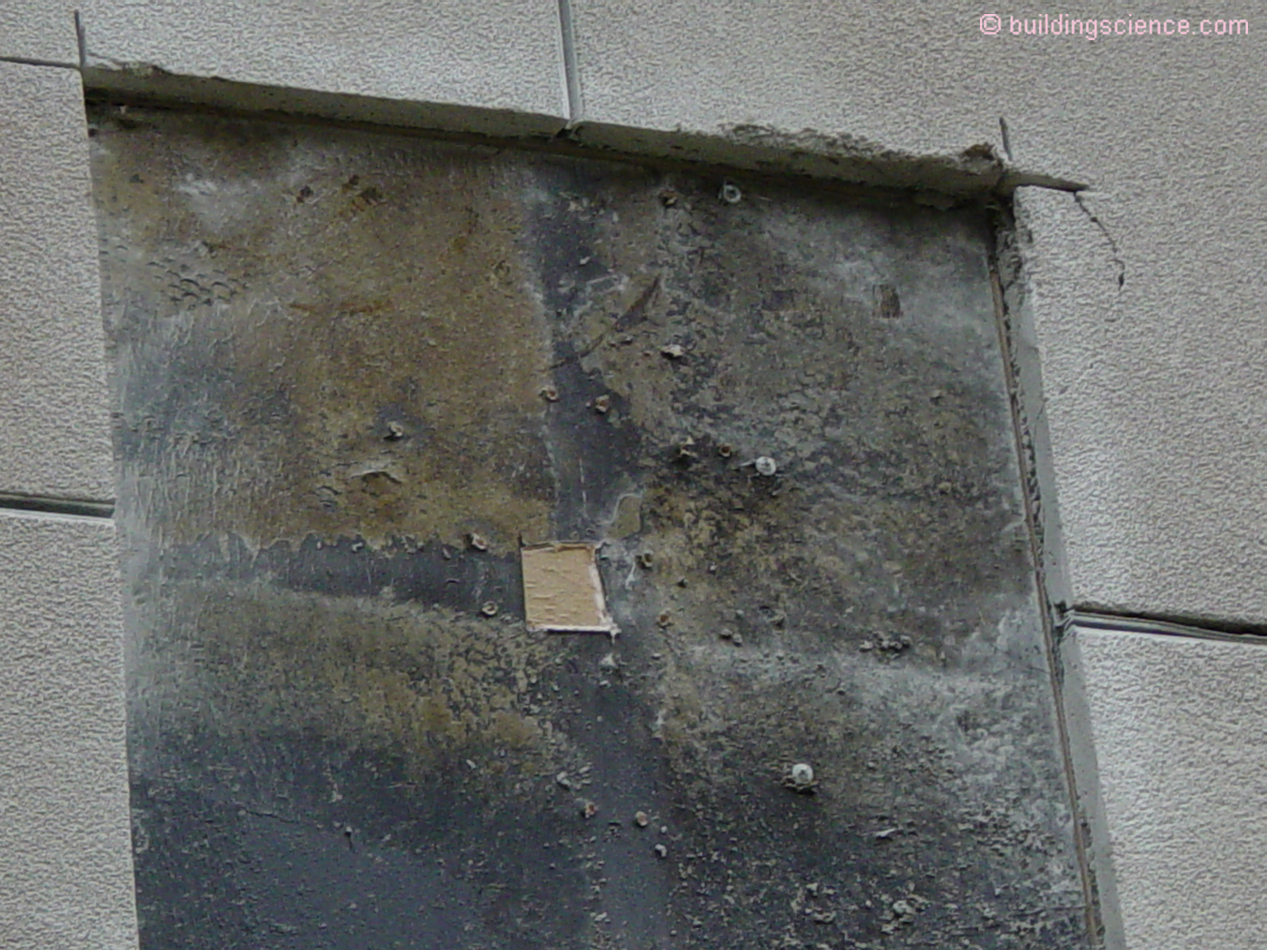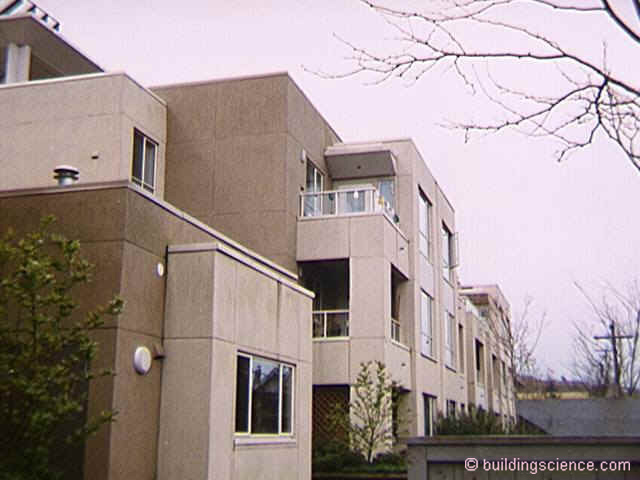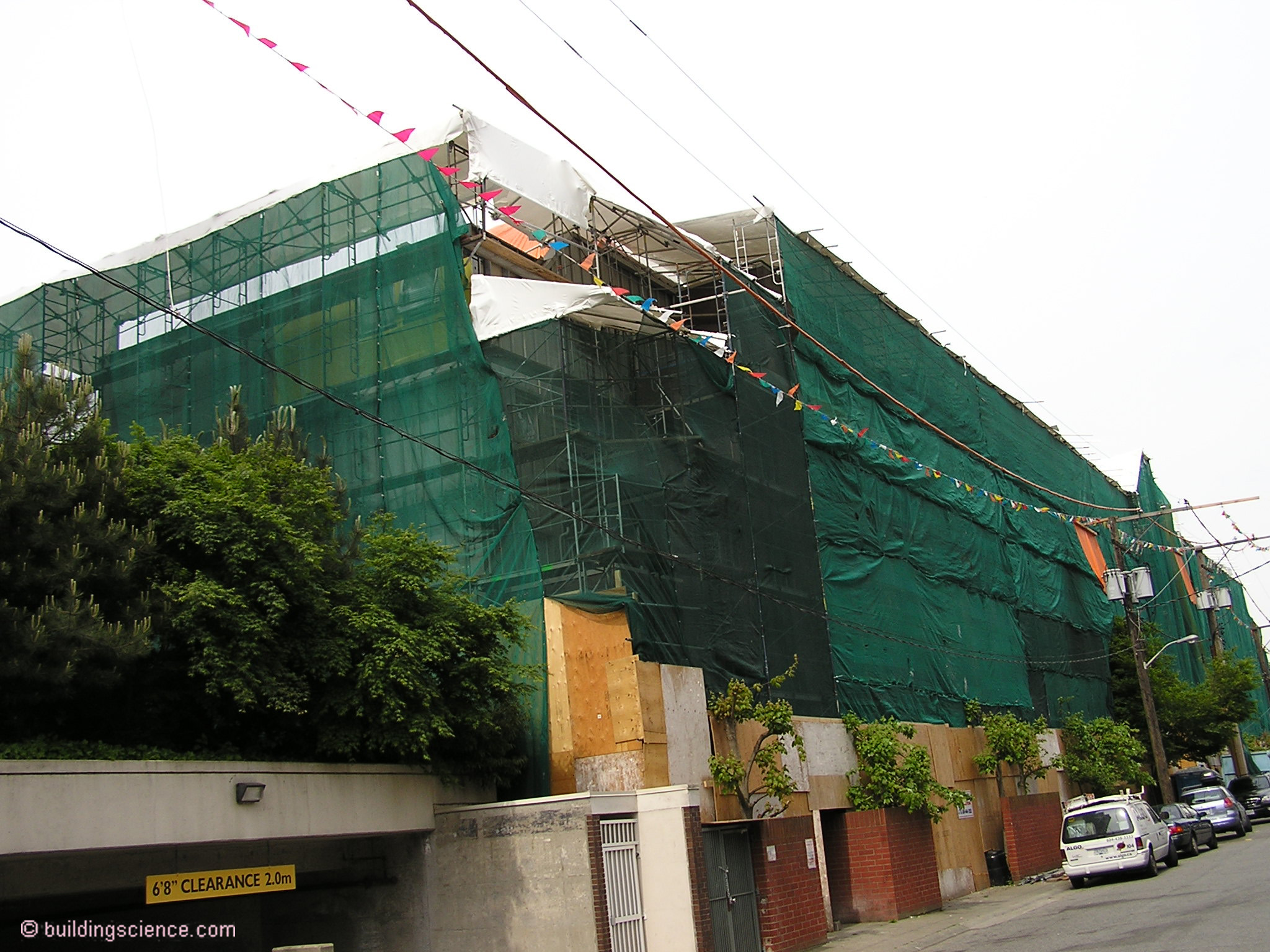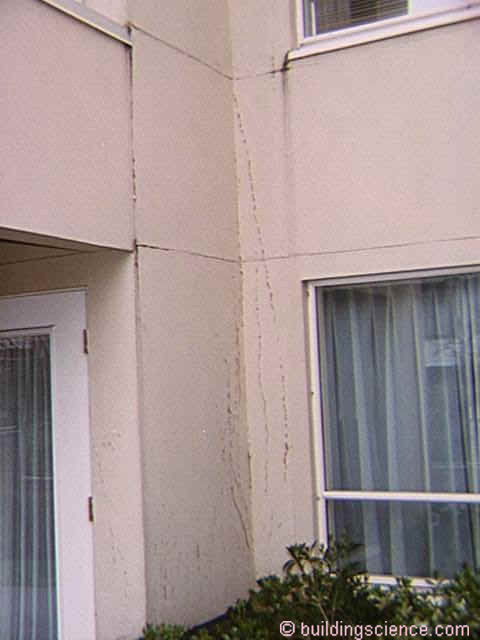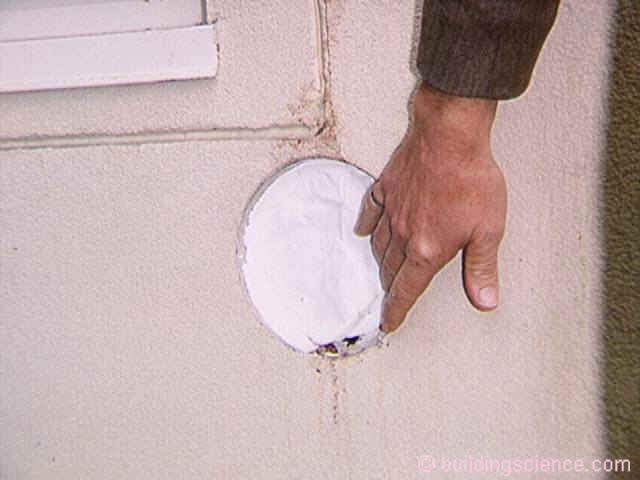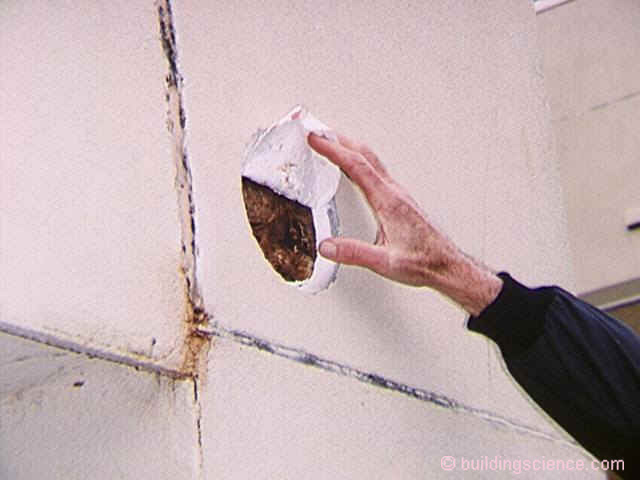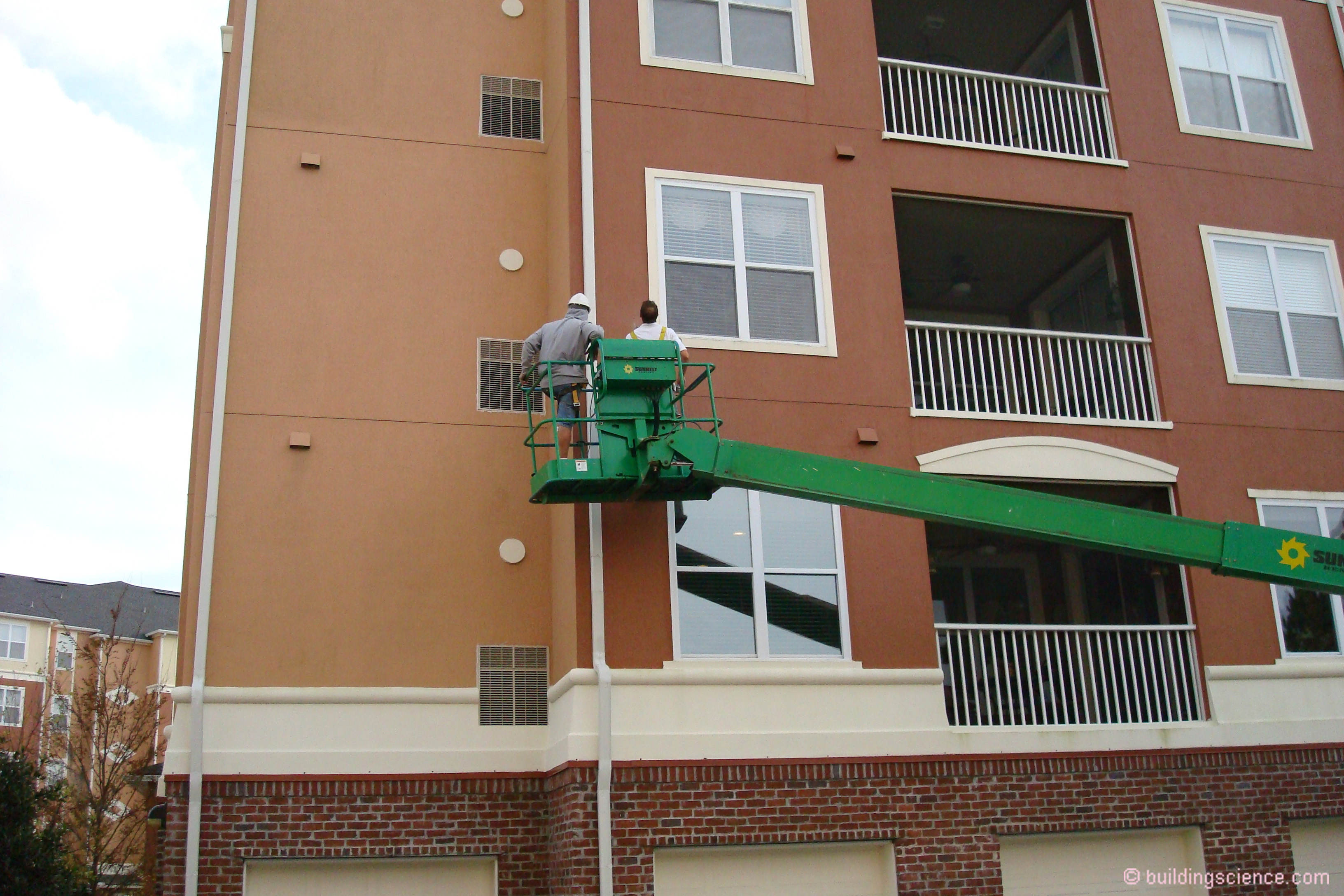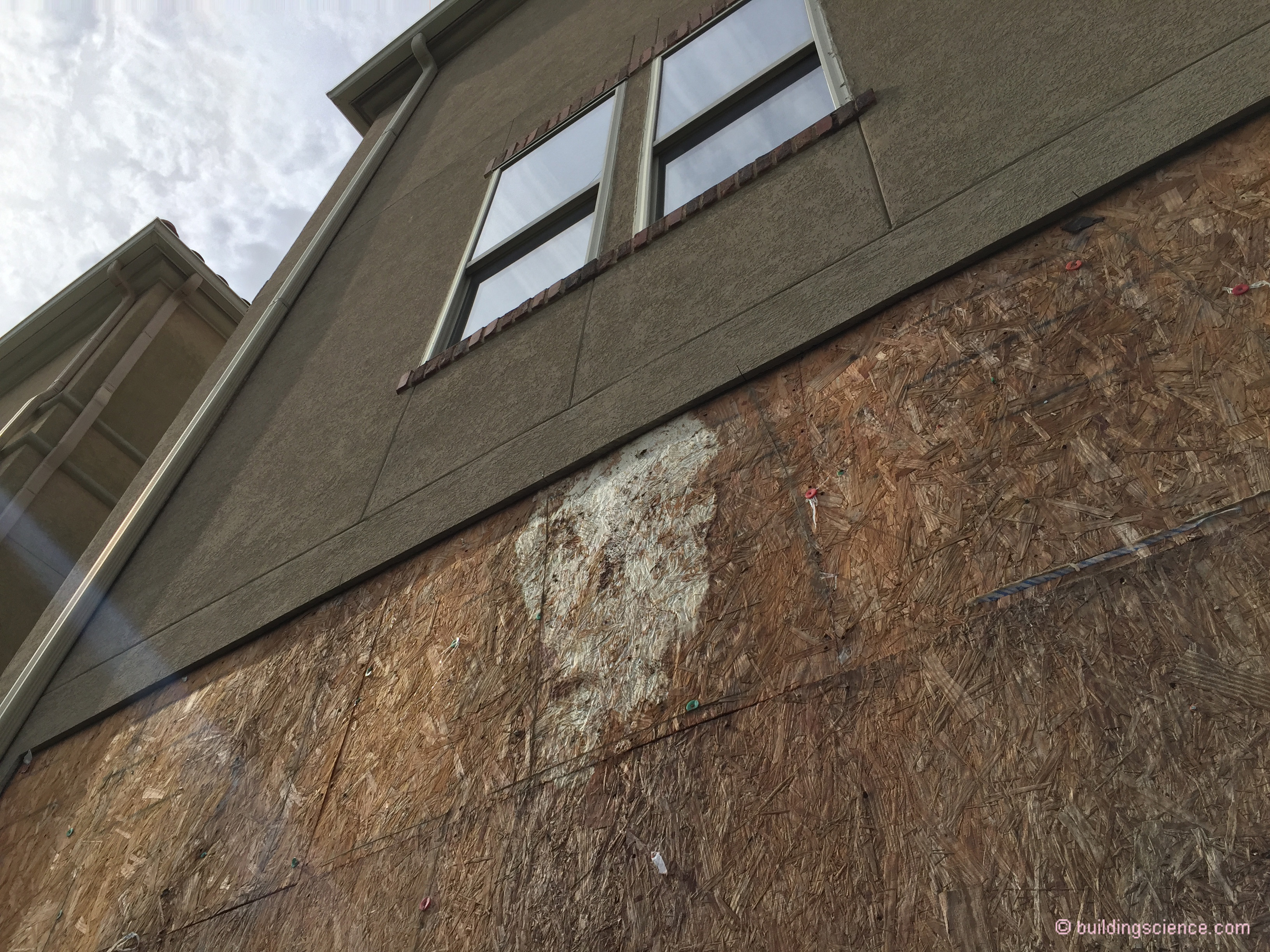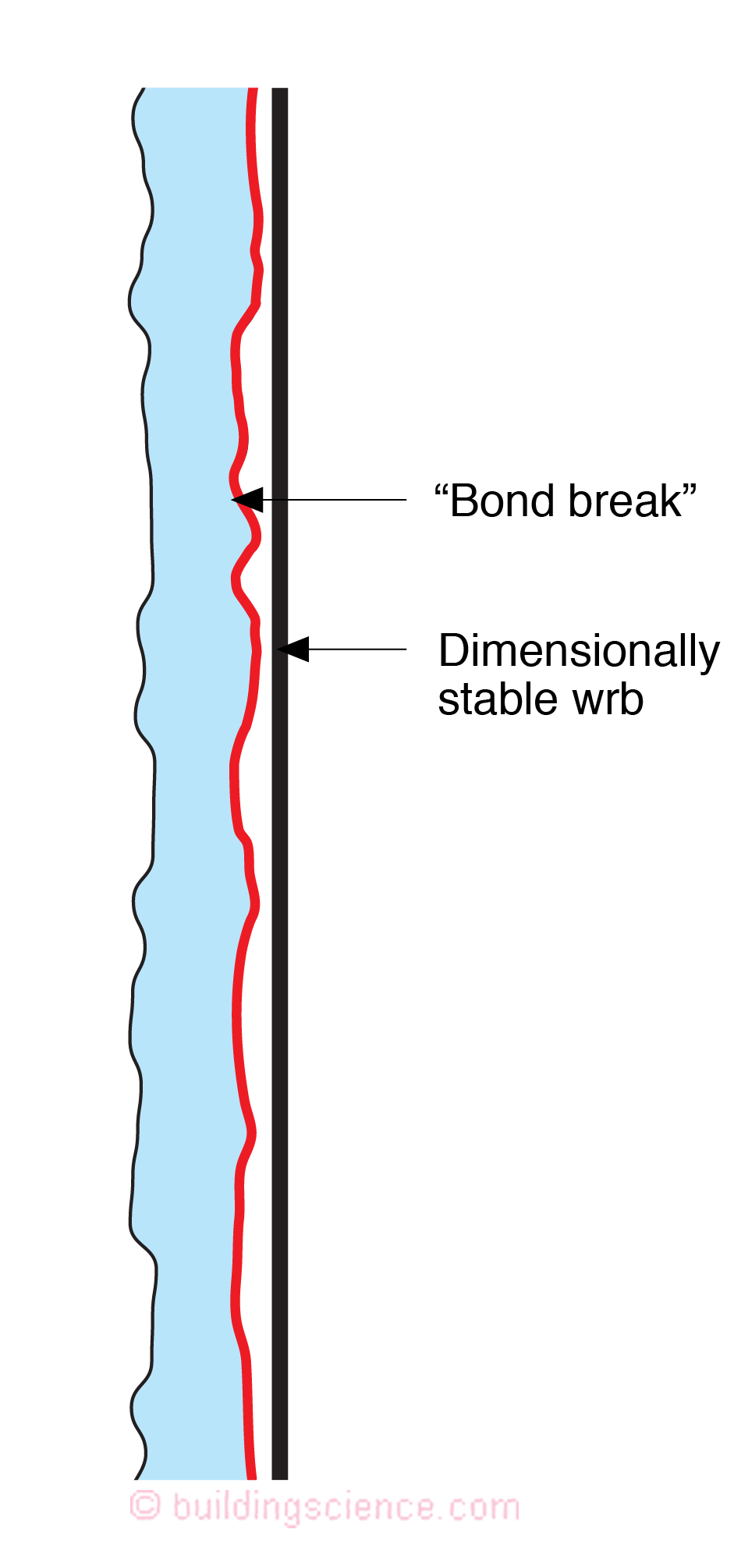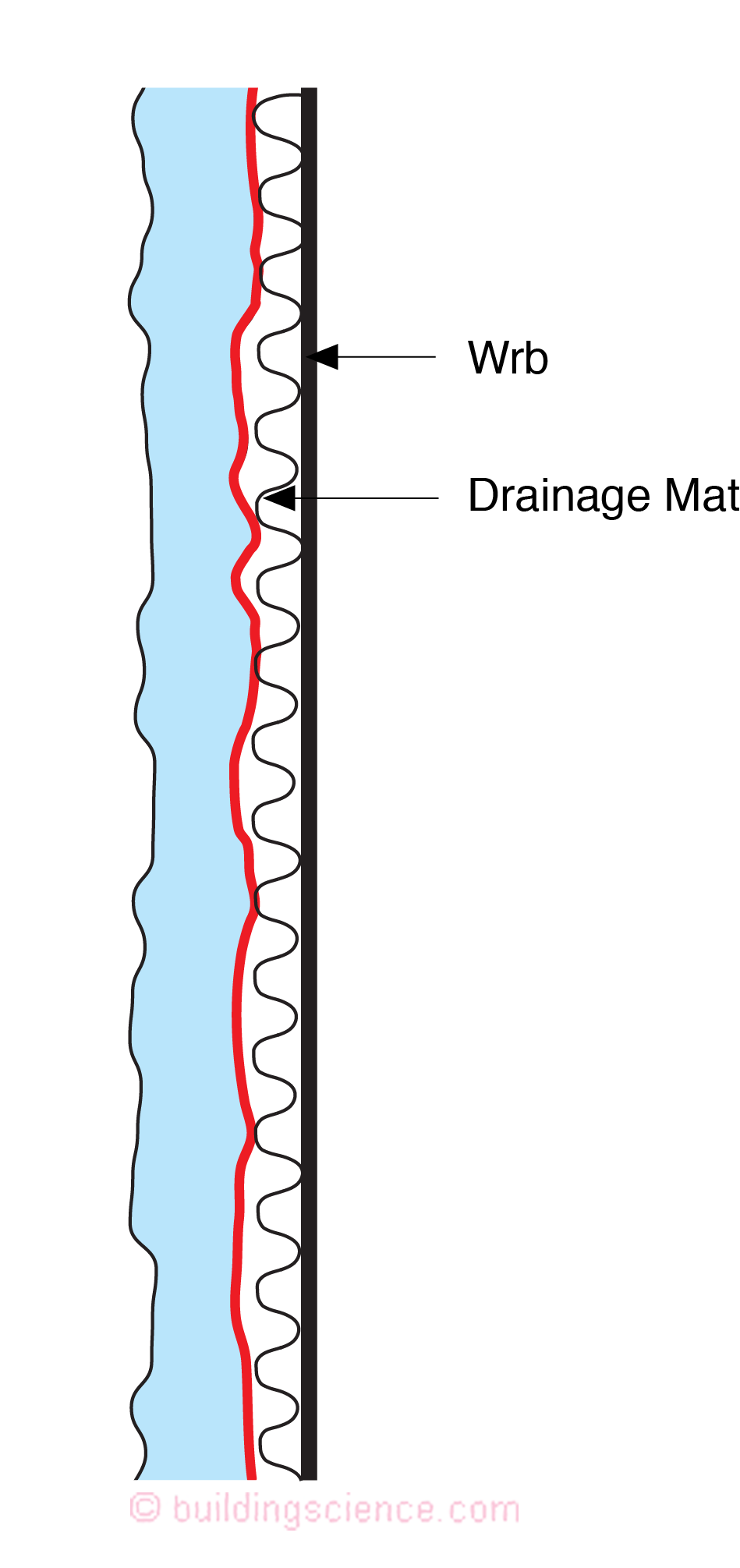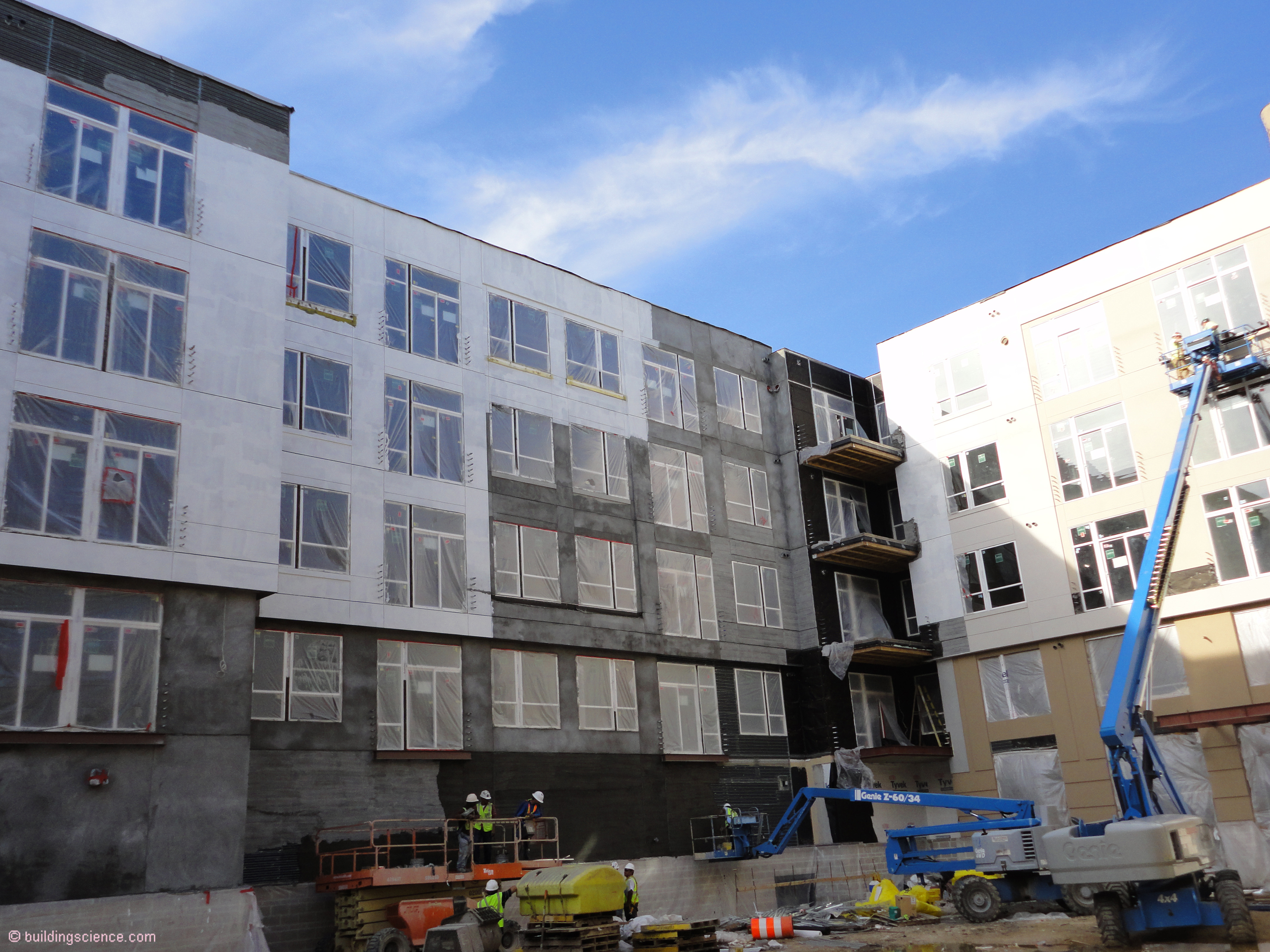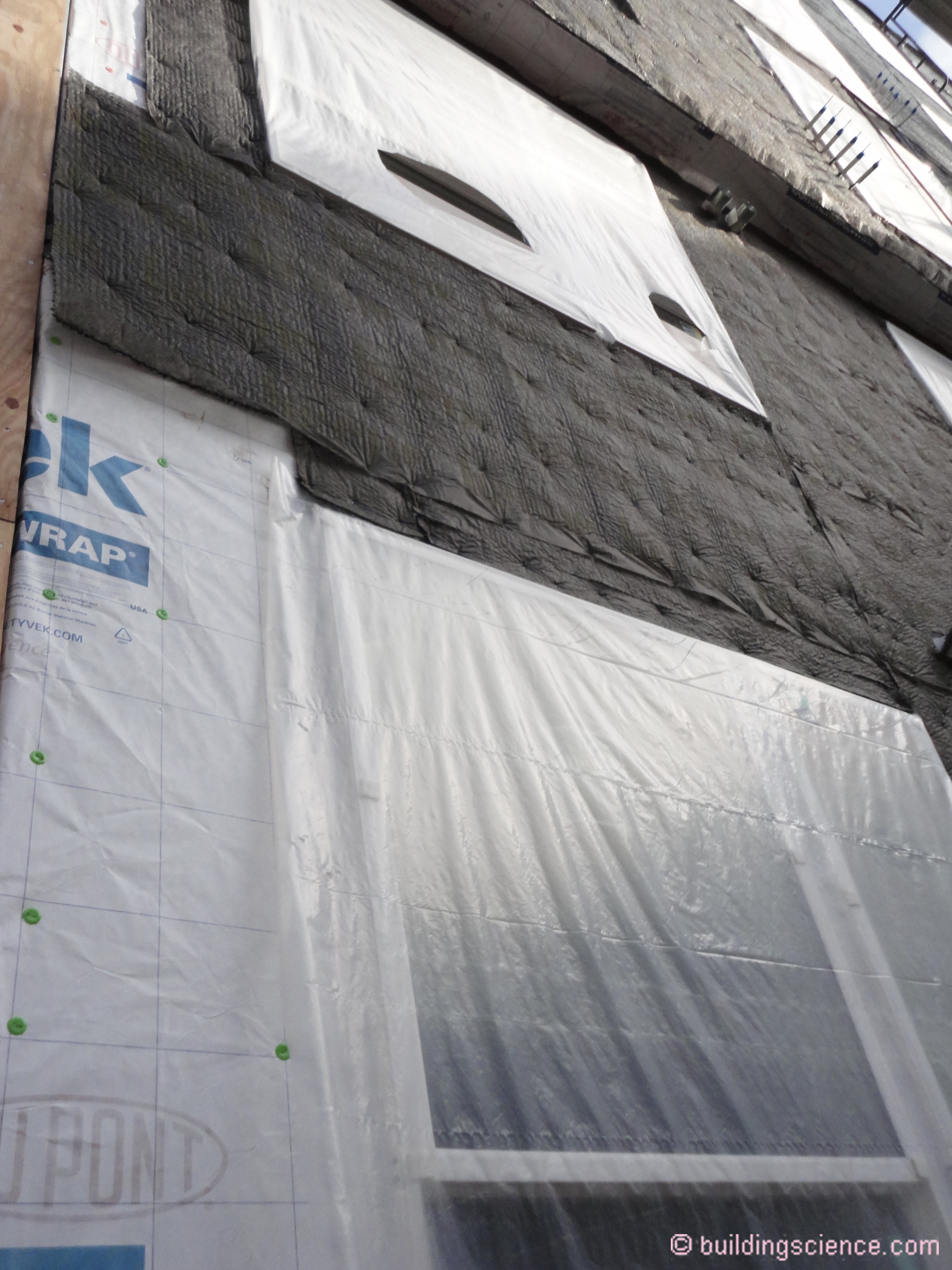How can you take a system with thousands of years of history and screw it up? Easy. Keep improving it until it does not work. Babylonians used it. Egyptians used it. Greeks used it. Romans used it (Photograph 1). Everyone used it…and everyone uses it. But it sure has changed and what we put it over sure has changed.
Photograph 1: Pompeii – Stucco applied over Roman brick. Minor issue with Mount Vesuvius in 79 A.D.
Over several millennia[1] stucco has gone from lime-based to lime-Portland cement-based to Portland cement-based to polymer modified….and each step of the way it has gotten stronger…and less vapor permeable.
Traditional lime based stucco | Greater than 20 perms |
Lime-Portland cement based stucco | 5 to 10 perms |
Portland cement based stucco | 1 to 5 perms |
Polymer modified stucco | Less than 1 perm |
This has had huge consequences. Duh. When walls get wet they can’t dry. They used to be able to. Today? Not so much.
Traditional lime based stucco was three layers: scratch coat, brown coat and finish coat (Figure 1). Each successive layer to the exterior was more vapor open than the layer it covered. Yup. Old timers had it dialed in. Today? Not so much.
Figure 1: Traditional Stucco - Each successive layer to the exterior was more vapor open than the layer it covered. Yup. Old timers had it dialed in. Today? Not so much.
Stucco historically had good compressive strength but not very good tensile strength. As we have manipulated the stucco “recipe” over the years, compressive strength has gotten better. And over the years so has tensile strength. To that end we have added cow dung, egg whites, pigs blood and finally polymers to the recipe. The “key” to the recipe is to create a strong “tinkertoy”[2] (Figure 2). The older stucco tinker-toys had larger “voids” than newer tinkertoys. Water molecules could move through the older stucco tinkertoys more easily than the newer tinkertoys. But all of the tinkertoys could be pulled apart pretty easily. So what to do? Ah, add another tinkertoy inside the voids of the original tinkertoy (Figure 3). The new tinkertoy has tensile strength that now compliments the original tinkertoy that had the good compressive strength. Good news. Except now the voids are much smaller because of this new tinkertoy taking up much of the space in the voids of the original tinkertoy. The water molecules don’t move so easily any more. Welcome to polymer modification.[3]
Figure 2: Stucco Tinkertoy - The older stucco tinker-toys had larger “voids” than newer tinkertoys. Water molecules could move through the older stucco tinkertoys more easily than the newer tinkertoys.
Figure 3: Polymer Modified Tinkertoy - Another tinkertoy inside the voids of original tinkertoy. This new tinkertoy has tensile strength that now compliments the original tinkertoy that had the good compressive strength. Good news. Except now the voids are much smaller because of this new tinkertoy taking up much of the space in the voids of the original tinkertoy.
The new recipe does not always follow the old rules laid out in Figure 1. Sometimes the finish coat and brown coat are less permeable than the scratch coat depending on what is added and how much. Oops.[4]
We used to put the stucco over brick and stone. If things got wet so what? Nothing to rot. And the walls were not insulated. Lots of energy flow. Lots of energy available for drying. Lots of drying. Life was good. Then we started to put stucco over wood. Wood rots. But it does not rot unless you get it real wet for a long time. We didn’t get the wood real wet for a long time. And more importantly it was real wood. And we didn’t insulate the walls. Lots of drying available even if the real wood got real wet. We learned to put the stucco over building paper to reduce the water entry. Life was still good.
Then we did three things. We stopped using real wood. We insulated…a lot. And we stopped putting the stucco over building paper.
We went from woven branches[5] to board sheathing. Then from board sheathing to plywood. Then finally from plywood to oriented strand board (OSB). We were here before (“The Evolution of Walls”, ASHRAE Journal, June 2009). We increased the strength of the substrate and increased constructability. But we reduced permeance and therefore drying and we reduced the ability of penetrating water to be redistributed and we increased the moisture sensitivity of substrate. We were also here before ("BSI-061: Inward Drive – Outward Drying", May 2017). None of this was good.
We then insulated. And we insulated. And insulated some more. This reduced the ability of the assemblies to dry when they got wet. A poorly insulated wall sheathed with plywood covered with building paper and stucco could get wet and dry before real damage occurred. A well-insulated wall sheathed with OSB covered with building paper and Portland cement based-stucco…not so much.
Could we make it worse? Yes, of course. We can improve building papers. We could make them dimensionally stable. When building papers (aka “water resistive barriers” wrb’s) were hygroscopic they expanded and contracted and stucco did not bond effectively to them (Figure 4). Manufacturers of building papers began to make them more hydrophobic and dimensionally stable. How could this be bad? We began to get the stucco bonding to building paper. When stucco bonds to building paper the building paper loses water repellency and its ability to drain (Photograph 2). Could we make it worse? Yes, of course. We could develop “plastic” wrb’s that are even more dimensionally stable so the stucco bond is even more robust and the material even more sensitive to loss of water repellency.
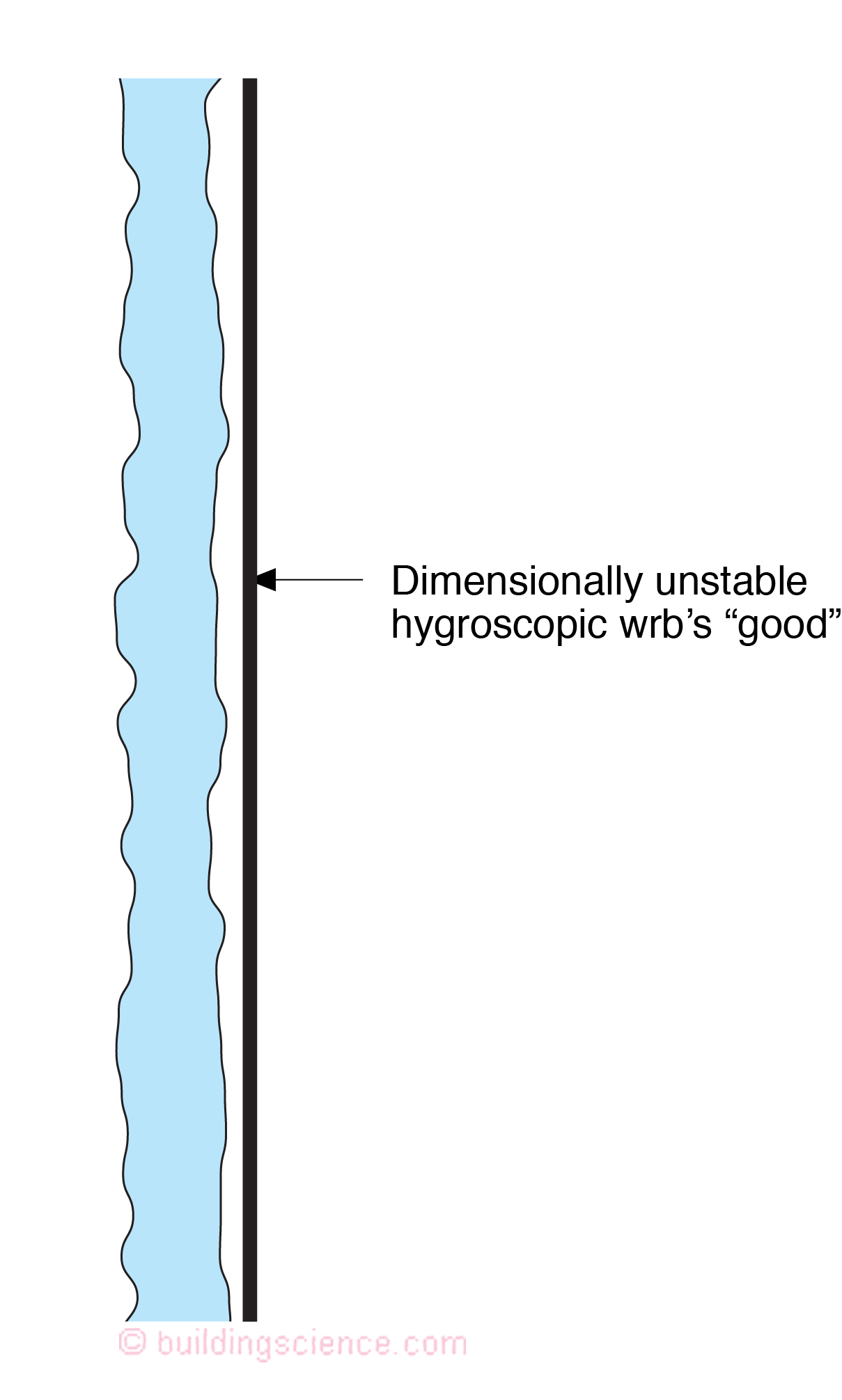
Figure 4: Dimensionally Unstable Building Paper - When building papers (aka “water resistive barriers” wrb’s) were hygroscopic they expanded and contracted and stucco did not bond effectively to them.
Photograph 2: Stucco Bonded to Building Paper - When stucco bonds to building paper the building paper loses water repellency and its’ ability to drain.
It all came together in Vancouver in the 1990’s and we almost rotted that great city to the ground. Low permeance stucco, high thermal resistance wall assemblies, OSB sheathing and dimensionally stable wrb’s.[6] You could tell you were in Vancouver based on the number of tarps and scaffolding covering the rotting buildings (Photograph 3 and Photograph 4).
Photograph 3: Vancouver Condo – Classic building design. Folks tried to blame the lack of overhangs…
Photograph 4: Vancouver Tarp - You could tell you were in Vancouver based on the number tarps and scaffolding covering the rotting buildings.
The images were dramatic….“crying” Vancouver stucco (Photograph 5)…stucco bonded to plastic wrb’s (Photograph 6)….and rotting OSB behind plastic wrb’s (Photograph 7). We should have paid attention. Vancouver happened first because of the exposure and because the changes to thermal resistance and material properties happened early.
Photograph 5: More Vancouver – “Crying” stucco.
Photograph 6: Still More Vancouver – Stucco bonded to plastic wrb.
Photograph 7: Vancouver End Game – Rotting OSB behind plastic wrb.
Then things began to move south and east. First on the multistory wood frame buildings because the rain exposure increases with height (Photograph 8) then on regular wood frame low rise (Photograph 9).
Photograph 8: Multistory Wood Frame - Things began to move south and east. First on the multistory wood frame buildings because the rain exposure increases with height.
Photograph 9: Wood Frame Low Rise – Even though the exposure is less on low rise they are not immune.
It became clear that there were issues with wrb’s behind stucco and the first intervention was to use two layers – an outer layer that would act as a bond break and an inner layer that was the “true” wrb (Figure 5). Unfortunately this was not enough.
Figure 5: Bond Break - It became clear that there were issues with wrb’s and the first intervention was to use two layers – an outer layer that would act as a bond break and an inner layer that was the “true” wrb.
The assemblies needed enhanced drainage and enhanced drying. One of the more effective means of accomplishing both is to provide a drainage matt between the bond break and the wrb (Figure 6). We have learned this on the multistory wood frame buildings (Photograph 10 and Photograph 11). We learned it on the multistory wood frame buildings first because they began to experience the problems first.
Figure 6: Drainage and Drying Gap - The assemblies needed enhanced drainage and enhanced drying. One of the more effective means of accomplishing both is to provide a drainage matt between the bond break and the wrb.
Photograph 10: Multistory Wood Frame Done Right - We learned to do it correctly on the multistory wood frame buildings first because they began to experience the problems first.
Photograph 11: Drainage and Drying Gap – Plastic wrb covered with a drainage mat with an integral bond break.
So what do we need to do? Easy. Provide a 3/8 inch air space behind stucco installed over OSB sheathing in regions where it rains more than 20 inches per year. That’s it.
Things are getting worse. But things have to get intolerably bad before we change. We didn’t learn from Vancouver. I predict that they are going to get intolerably bad sooner than later. The stucco-pocalypse is coming.
References
Mukhopadhyaya, P., Kumaran, K., Plescia, S., Lackey, J., Normandin, N., and van Reenen, D., “Development of high performance stucco as cladding material”, IRC MEWS, Ottawa, 2007.
Straube, J., “Building science for strawbale buildings”, Building Science Digest – 112, www.buildingscience.com, 2009.
[1] ”kiloyears” Yes, this is a valid term. Who knew?
[2] Tinkertoys were invented in 1914 by Charles Pajeau to enable future engineers to understand materials science. Pajeau was a stonemason. It doesn’t get better than this….
[3] Apologies to real material scientists and chemical engineers for this over simplification of the real world.
[4] Not good when you are on the coast of a big body of water with salt in it….salt solution gets in…phase change happens…salt gets left behind…osmosis…fun…blisters…bond failure…
[5] Wattle and daub
[6] Vancouver also had interior polyethylene vapor barriers that completely eliminated any interior drying. Made it worse. But even if there had been no poly the buildings were doomed….it just would have taken a little longer….

